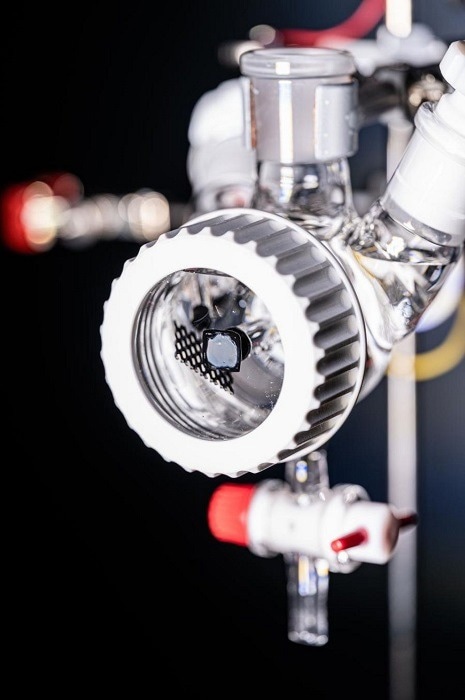Researchers worldwide are striving to develop more efficient hydrogen production methods, which, if powered by renewable energy sources, could significantly reduce fossil fuel consumption.

The photoelectrochemical Schlenk cell in the solar simulator. The rectangular gray area with black framing in the foreground is the photoelectrochemical solar cell. Image Credit: University of Tübingen
Unfortunately, current climate-neutral hydrogen production technologies remain too inefficient or costly for widespread use. However, a research team from the University of Tübingen has introduced an innovative solar cell with outstanding efficiency. This breakthrough enables decentralized hydrogen production and holds promise for industrial-scale implementation, as detailed in their publication in Cell Reports Physical Science.
A Solar Cell on a Dive
“Green hydrogen” is the term used to describe hydrogen generated through water electrolysis using renewable energy, which ensures environmentally friendly production. Solar water splitting, often likened to artificial photosynthesis, harnesses solar energy to produce hydrogen.
Dr. Matthias May’s research team at the University of Tübingen’s Institute of Physical and Theoretical Chemistry has devised a solar cell that seamlessly integrates into the photoelectrochemical system and collaborates directly with the water-splitting catalysts. Notably, the unique aspect of Tübingen’s development eliminates the need for an additional external circuit, as typically required in photovoltaic solar panels.
This innovative approach results in a more compact, flexible, and potentially cost-efficient technology. However, it also places higher demands on the solar cell itself.
Among researchers in the field, realizing stable and efficient photoelectrochemical or direct water splitting is something of a holy grail.
Dr. Matthias May, Institute of Physical and Theoretical Chemistry, University of Tübingen
The distinctive aspect of the solar cell structure lies in its precise control over the interfaces between various materials. Surface structures are meticulously crafted and examined on a nanoscale, measuring just a few nanometers or millionths of a millimeter. Of particular concern are minute crystalline defects that can emerge during the growth of solar cell layers. These defects can alter the electronic structure, potentially diminishing both the efficiency and stability of the system.
Overall, however, corrosion – and thus the long-term stability of the solar cell in water – is still the greatest challenge. In this, we have now made great progress compared to our earlier work.
Dr. Matthias May, Institute of Physical and Theoretical Chemistry, University of Tübingen
The technical design of the new cell is both groundbreaking and remarkably efficient. The cell's efficiency rating measures the proportion of sunlight energy that can be converted into usable hydrogen energy (calorific value).
The research team has achieved an impressive efficiency of 18%, marking the second-highest value ever recorded for direct solar water splitting. The initial notable efficiencies in solar water splitting, presented by NREL in the USA in 1998, stood at 12%. Subsequent advancements saw an increase of 14% in 2015 and a peak of 19% in 2018.
Large-Scale Application Conceivable
Various initiatives at different universities have shown that the technology can be commercialized even with lower efficiencies.
What we have developed here is a technology for solar hydrogen production that does not require a high-performance connection to the electricity grid. This means that permanent smaller stand-alone solutions for energy supply are also conceivable.
Erica Schmitt, Study First Author, University of Tübingen
The Tübingen project is part of the collaborative effort H2Demo, which includes external partners such as the Fraunhofer Institute for Solar Energy Systems (ISE). The upcoming stages of development will focus on enhancing long-term stability, transitioning to a more cost-effective silicon-based material system, and expanding to cover larger surface areas. These research outcomes have the potential to play a substantial role in bolstering energy provision and reducing CO2 emissions.
Journal Reference
Schmitt, E. A., et al. (2023). Photoelectrochemical Schlenk cell functionalization of multi-junction water-splitting photoelectrodes. Cell Reports Physical Science. doi.org/10.1016/j.xcrp.2023.101606.